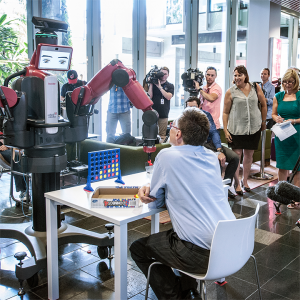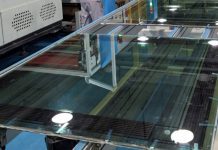Minister for Education and Training, the Hon. Christopher Pyne MP, assisted by Queensland University of Technology’s (QUT) Baxter robot launched the new ARC Centre of Excellence for Robotic Vision (ACRV).

The new centre will focus on developing new technology to create the next generation of robots that “can see and respond as humans do”.
“Once robots can see and understand the environment they operate in they can make decisions that allow them to work safely beside us,” said Professor Peter Corke, world-renowned roboticist with QUT’s Science and Engineering Faculty and Director of ACRV.
“Current industrial robots are dangerous for humans to work around because they’re simply not equipped to recognise and avoid obstacles suddenly in their way. Baxter uses a range of sensors to detect movement around it, as well as spring-loaded joints which stop it continuing a pre-programmed movement if it meets an unexpected obstacle. We’ve tried to ‘rush’ Baxter before and can certainly vouch for his quick reflexes.”
At ACRV, Australia’s top computer vision and robotics researchers are working on the use of robotic vision to create advanced farming tools, tackle Crown of Thorn starfish outbreaks on the Great Barrier Reef and develop low-cost solutions for key health and medical problems.
“Robotic vision is the key enabling technology that will allow robotics to transform labour-intensive industries, disrupt stagnant markets and see robots become a ubiquitous feature of the modern world,” ACRV Chief Operating Officer Dr Sue Keay said in a news release.
“We consider that ‘seeing’ is far more than just processing images. It’s a complex process tightly coupled to both memory and action, which gives robots the understanding they need to robustly perform tasks that involve objects and places while at the same time providing rapid and continuous feedback for control. Robotic automation has transformed manufacturing, household cleaning and soon cars but robotics has made relatively little headway in other industries where the world is complex and time varying, like retail. Robots that can see, learn and respond as humans do will increase productivity in industries critical to Australia’s economy.”
In a media release, Australian Research Council (ARC) Chief Executive Officer (CEO), Professor Aidan Byrne welcomed the launch of the new centre.
“This Centre has identified a key challenge—that of uniting artificial intelligence and robotic vision—and it has brought that challenge into focus with a high-calibre team. The Centre’s partners comprise global leading investigators and organisations in robotics and computer vision, including: the Georgia Institute of Technology, USA; INRIA, the French Institute for Research in Computer Science and Automation; and the Swiss Federal Institute of Technology,” Professor Byrne said.
“This Centre has funding security for seven years which allows researchers the time to nurture ideas from conception to reality—the reality being a robot that can see as humans do. The Centre is also a training ground for students and will nurture a wealth of talent in robotics and computer vision giving students the opportunity to learn what it takes to be an entrepreneur.”
QUT was awarded $19 million in ARC funding for the Centre.

















